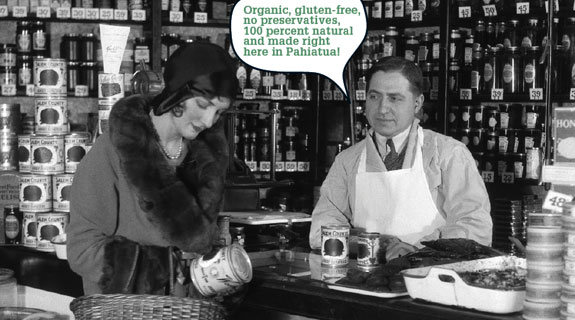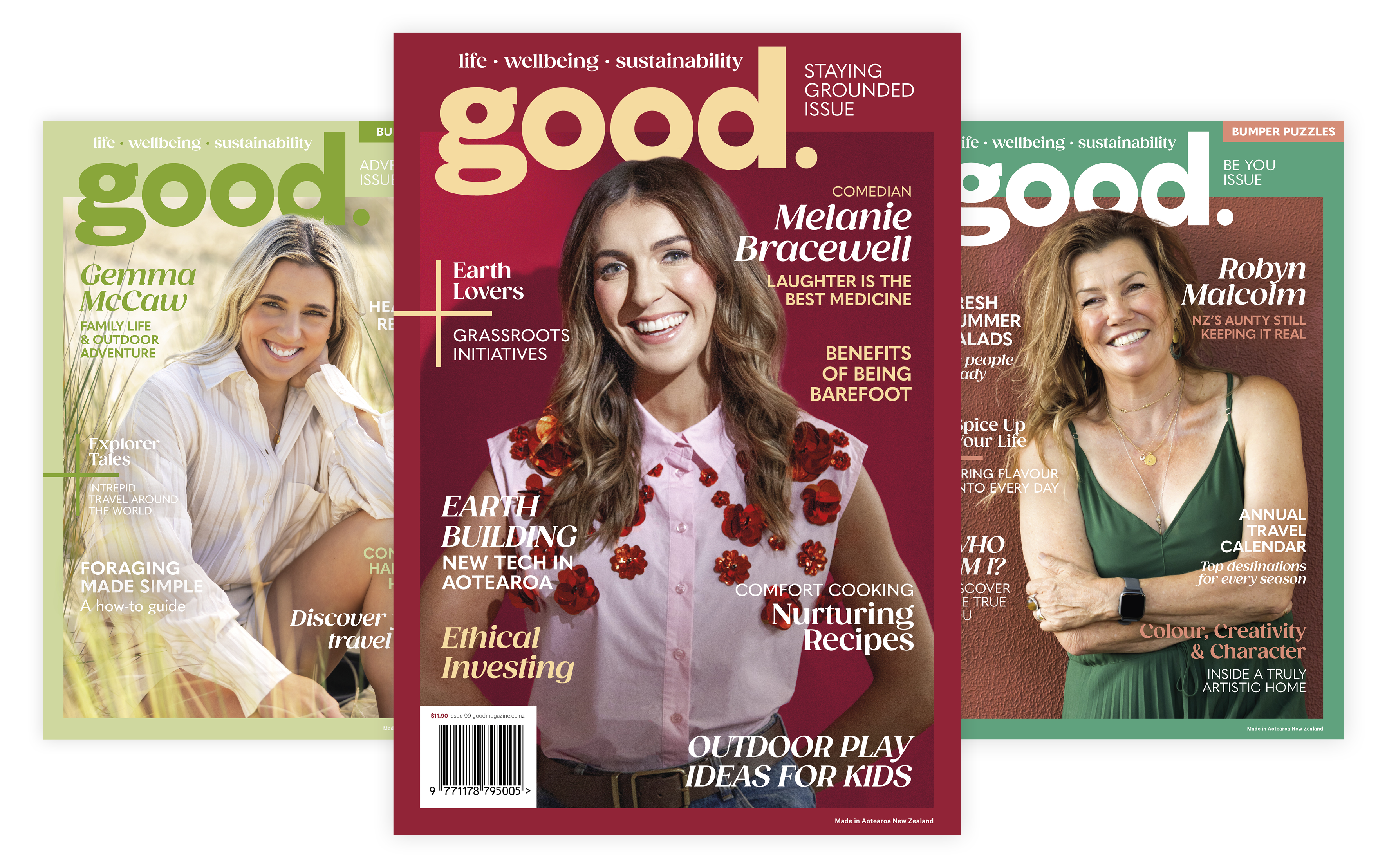Trying to eat healthy and please the family, while being kind to the environment and your wallet? It’s tough—but not impossible, says Andy Kenworthy. Here’s how to outsmart your supermarket, with shopping strategies for families of all sizes.
For good food from the supermarket without going off your trolley—or spending a fortune—ignore the mind control and keep it seasonal and simple. Andy Kenworthy reports from the aisles.
Illustrations by Jo Thapa
Being an ethical food shopper gives me a headache. Is my coffee fair trade? Organic? Shade grown? Were these bananas picked by an exploited plantation worker? Do I recognise these frozen peas from that recent health scare? Has my pizza been touched by the greasy palms of the palm oil industry? How far from home is this ‘authentic’ curry sauce, and how long has it been on the road? Does this brand of biscuits come from a global conglomerate without a crumb of conscience? Why does the back of this carton of juice, covered in pictures of luscious wet fruit, read like a shopping list for a chemical weapons factory? Is the dog’s shampoo tested on animals? Hang on, shouldn’t it be? And on, and on, and on.
Next, I try giving this bewildering array of parameters some kind of relative value. What’s better: fair trade sugar that supports the indigenous people of Ouagadougou, or Chelsea Organic, which is processed here and partly sourced from Oz? This creates such a quantum leap in complexity I’ll be lucky if I make it to the checkout before inflation pushes my purchases out of my price range.
I’m vegetarian, which tips the ecological scales slightly in my favour and reduces my confusion by cutting down the options. Sadly, it sometimes cuts down the options to the extent that there aren’t any, and a smug glow in the belly is never very filling at supper time.
Supermarkets spend loads of time and cash working out how people move through their shops, how they buy and when they buy. It’s called ‘neuromarketing’ … The shelves are not stocked for your convenience, they are stocked to maximise sales
I have a vegetable patch. It currently contains three gigantic silver beet, three spring onions, some lettuce and a rose bush, which is not really enough to live on.
I buy as much stuff under the fair trade and various organic banners as I can, and it’s great to see that more and more of it is hitting the shelves. But since I’m not an investment banker, the Prime Minister, or both, there’s a limit to that as well.
Given that people like you and I still have to use supermarkets, how do we ensure we shop effectively without blowing the budget—or selling out our beliefs?
Psych ’em out
First, let’s arm ourselves with a little knowledge about how supermarkets work. The moment we walk through the door, we enter a carefully controlled environment designed exclusively to do two things: fill up our trolleys and empty our bank accounts. To this end, supermarkets spend loads of time and cash working out how people move through their shops, how they buy and when they buy.
It’s called ‘neuromarketing’. The gorgeous aroma wafting from the bakery is not just a by-product of bread making. It’s also there to make you feel hungry, so you’ll buy more food. The mellow in-store muzak is there to slow you down, so you will spend longer browsing the shelves. And the shelves are not stocked for your convenience, they are stocked to maximise sales.
For example, the first things you come to in most supermarkets are the fresh fruit and veggies, which makes no sense. They can be easily damaged, so you spend the whole time digging them out from under your tins and bottles. But research suggests the experience of selecting wholesome, fresh food at the outset of a shopping spree makes people feel less guilty about stocking up on rubbish later on.
More expensive items, or items the store particularly wants to sell, will tend to be placed at eye level or just above it, because this is where most people look first. Sumptuously branded product lines from the best-known producers will hog the limelight, while cheaper home brands languish somewhere near your ankles. Many producers actually pay for this prime positioning.
For similar reasons, products intended for children will usually sport the colours of a nuclear explosion and sit on shelves within easy sight and reach of your offspring.
Products, sometimes even whole sections, are periodically moved from one aisle to another in the hope you’ll collect other items as you search for what you originally came for.
Brightly coloured tags on the shelves might point you in the direction of a sale item, or they may say something meaningless like “Everyday low price!” to draw your attention to the items the store wants to shift. At the checkout queue either you or your children may be feeling tired, peckish or bored, which is why those shelves are full of chocolate—and magazines.
Strategies for smarter shopping
Supermarket owners aren’t necessarily evil or manipulative—they’re just good at their jobs. The good news for customers is that knowledge is power, and you can fight back.
First, try going to the supermarket as infrequently as possible. If you do all your shopping in one go, it’s easier to stick to a budget and avoid impulse buys. Switching from a weekly to a fortnightly—or even a monthly—shop for non-perishable goods can save you a small fortune.
A great way to bypass in-store neuromarketing is to shop online. This reduces the time spent shopping as well as the stress, and you don’t need to drive to the store. According to Grant Carran, managing director of the Food Direct online shopping service (www.fooddirect.co.nz), each delivery van reduces the number of cars on the road by up to 40 journeys every day.
“Our family would drive from our favourite greengrocer to the butcher, to the bakery, to the organic store, to the gourmet food store and then to the fish market,” he says. “This was fun the first few times, but we soon realised we were spending a lot of time in traffic and money on gas, and that this was not good for us or the environment.”
When you shop at home you can check the contents of your pantry as you go, and if you have time you can Google the ethical credentials of potential purchases before selecting them. And because the system adds up your bill as you shop, you can stick to your budget without the embarrassment of abandoning items at the checkout. Once you’ve cracked the supermarket’s website you’re more likely to discover other ethical, eco or organic choices online. And if you get hungry looking at all that food, you can grab a much cheaper, healthier snack than you’d buy in-store.
When you do go to the supermarket, take a detailed, budgeted list of what you want and ignore aisles you don’t need to go down. As you move along the shelves, keep your budget in mind and aim low. But remember, it’s still more expensive to buy sale items than not buy them at all, if you don’t need them.
Check out supermarket ‘own brand’ products. As well as being relatively cheap, they can be quite healthy, with less salt and sugar than some of their more well-known competitors. Often, the package contents are exactly the same as those of familiar brands produced by the same manufacturers: savings are made by cutting the flash packaging and clever marketing.
Check the unit price, not the overall price. Bulk buying can save cash, packaging and reduce the number of car trips to the store—but sometimes it’s no cheaper, and buying smaller quantities ensures the product won’t spoil before it’s used.
What do the experts recommend? Laura Faire recently worked with Kathryn Hawkins on the book Shop Local Eat Well: Cooking with Seasonal Produce in New Zealand. She says the key to smarter shopping is to buy simple, unprocessed ingredients that are local and in season.
“The best way to shop ethically is to buy New Zealand-grown,” she says. “If you can buy in season it’s cheaper too.
“If you think about it, supermarkets have an incentive to source locally. It’s all about shelf life. They offer the options; it’s up to consumers to buy them. The more local produce we buy, the more they will put on the shelves.”
Seasonality can vary from region to region, so you may need to consult a friendly gardener or grocer. Fresh produce is toughest to find around springtime, when everything is growing but nothing is ready.
Green Party MP Sue Kedgley has been campaigning on food issues for more than a decade, running her own ‘Shop with Sue’ sessions to help guide people around their local supermarkets, but she doesn’t think it’s getting any easier to shop healthily, or even ethically.
Sue reckons it’s not fair that to find out what’s in things we have to rely on a ‘nutrition panel’, which often requires a magnifying glass to read and night classes to understand.
There have been some small signs of progress recently, however. “Things have got better with eggs, at least you can check whether they are caged hens, barn hens or free range,” she says. Sue’s still pushing for mandatory country-of-origin labelling for fruit and vegetables, but in its absence the supermarkets have started their own voluntary systems.
Sue believes your choice of supermarket is crucial. She recommends New World, Pak’n Save and Four Square, as they’re all owned by Foodstuffs—a New Zealand-run cooperative of shop owners.
And what about the world beyond the supermarket—there must still be convenient, good food out there, surely?
You could try a veggie box delivery. Their products are usually seasonal, carefully sourced, well labelled, and come with complementary positive vibes. A ‘family box’ will set you back anywhere from $40 to $60. There is an inherent inflexibility in committing to a box at a time. Your good intentions on ordering day could leave you with an overflowing compost bin if you don’t snack on carrot and celery sticks as often as you imagined you would. The ordering systems also require careful management to avoid a surplus of an undoubtedly wholesome but nonetheless uneaten product. (I cancelled my veggie box delivery after being overwhelmed with citrus fruit. The week after I finally remembered to cancel the oranges, they helpfully sent some tangerines instead.) On the other hand, the weekly delivery encourages you to cook and eat a wider range of fruits and vegetables than you might otherwise select yourself.
Food co-ops are another option. They bring people together to buy from companies like Ceres Enterprises, which supply bulk organic, fair trade and ethical products at wholesale prices. It’s a great way to get these goods less expensively, if not actually cheaply. You have to buy large amounts (12 packages of organic tea per carton, for example), but most co-ops will swap individual items. Otherwise, you can organise your own ‘sub co-op’ with friends, and split up your bulk buys that way.
Shopping smarter won’t make all of our ethical food dilemmas go away, but maybe we should be thankful for them. Too many people on this planet can ask just one food question each day—is there going to be enough of it? The fact that we’re asking ourselves some tough questions about what we eat is testament to the hard work of campaigners and grass-roots movements all over the world. By continuing to grapple with these issues, we increase our understanding of the interconnectedness of our world.
If you want something from your supermarket, ask for it.

The realists
Who: A suburban family with three hungry teens and their numerous hangers-on
Challenge: Sourcing quality food in sufficient quantities to feed the starving hordes
Strategies:
- Eat seasonal fruit and veggies for fresh, local and inexpensive food. Find a competitively priced local greengrocer and take advantage of their specials.
- Talk to your nearest organic butcher about buying a whole, half- or quarter-animal at a time, and invest in a chest freezer to store it and other bulk purchases.
- Soup is a great, tried-and-tested way to feed kids lots of veggies and to make meat go a long way.
- Save bread by making bread. Get that breadmaker humming to fill ’em up on nutritious loaves and make dough for pizzas—get the kids using it too. Try making your own jam, too.
- Divide the veggie garden into individual plots and give kids their own plants to grow.

The idealist
Who: Mid-20s single urbanite
Challenge: Buys fresh organic produce from the local wholefood store, only to have it slowly rot in the fridge because the film festival’s in town
Strategies:
- Garden on a small scale, starting with herbs and tomatoes in pots.
- Get social by joining your local community or guerrilla gardening group.
- Eating raw foods and nuts is a quick, no-waste approach for solitary diners.
- When you do cook meals, avoid waste by packing leftovers for lunch at work.
- Save money and time by ordering fair trade coffee, tea, sugar and drinking chocolate online (www.tradeaid.org.nz/Fair Trade Cafeteria Supplies); sign up your workplace while you’re at it.

The economists
Who: Late-30s couple with a new baby
Challenge: Embracing organics with new enthusiasm while grappling with the constraints of living on a single income
Strategies:
- Keep it simple in the garden. Silver beet and pumpkins are easy to grow and make great baby food. Fruit trees planted now will grow up with your child.
- Create a kitchen garden with herbs and salad greens in an easy-access location close to the door.
- Being home with little ones is a great opportunity to resurrect the art of cost-effective entertaining: simple barbies and slow roasts.
- Use new networks (antenatal class, kindy or coffee groups) to find people with surplus garden produce to swap.
- Keep costs down by joining a food co-op with friends, networks or neighbours.

The sensualists
Who: Boomers with an empty nest and a taste for luxury
Challenge: What’s the point of grocery shopping when no one’s home to eat?
Strategies:
- Budgetary considerations may be less of a concern—but where to put your food dollars matters more than ever. Support local producers of quality artisan food, local-food restaurants and cafes that sell fair trade coffee.
- If you’re keen to start an edible garden but your back’s not up to the manual labour, hire a gardener or a couple of students to do the digging for you.
- Visit local microbreweries and vineyards. Some of the finest tipples may come from just around the corner. Why not try your hand at home-brewing beer or apple cider?
- If you’ve got a family-sized lawn with no one to play on it, think about keeping chooks for perfectly fresh eggs and a great excuse to get to know your neighbours.
- Now that you don’t have to pump out meals to feed the hungry hordes, how about becoming the gourmet chef you’ve always dreamed of being? It’s a great way to get to know quality food and quality people, especially if you join a Slow Food convivium (www.slowfood.com).
How to eat healthy: all you need to know
Don’t eat anything your great grandmother wouldn’t recognise as food, writes best-selling author Michael Pollan.
His latest book, In Defence of Food, contains many such common-sense guidelines for navigating the complex culinary landscape that we find ourselves in.
Don’t eat anything that’s incapable of rotting is another of Pollan’s eminently sensible suggestions.
Shop at the peripheries of the supermarket and stay out of the middle. Most supermarkets are laid out the same way: processed foods dominate the central aisles, while fresh foods—dairy, produce, meat and fish—line the walls.
Avoid products containing ingredients that are a) unfamiliar, b) unpronounceable, c) more than five in number or d) that contain high-fructose corn syrup. While none of these characteristics are necessarily harmful in themselves, they’re all reliable clues that foods have been processed to the point that they’ve ceased to be real food and have instead become ‘food products’.
Remember when margarine’s trans-fat made it a wonder food? Avoid food products that make health claims, suggests Pollan. For a food product to make a health claim it must first have a package—so it’s already more likely to be a processed food than a wholefood. Past experience suggests that the bolder the health claim, the greater the chance it’s founded on incomplete and erroneous science.
Real food is more than the sum of its nutrients and a diet is more than the sum of its foods, says Pollan. The ‘nutritionist approach’ treats food (fish, eggs, carrots) not as whole entities but as a series of disparate parts (omega 3, cholesterol, carotene). Problem is, scientists have an incomplete understanding of food and how it affects us. To follow the food industry’s conflicting and self-interested advice is to be at the mercy of dodgy thinking, fads and fashion.
Instead, shake the hand that feeds you. Find a local organic co-op, start a garden.
Eat slowly, with others and at a table. Historically, food was about pleasure, community, family and spirituality. The more we worry about nutrition, the fatter and less healthy we seem to become.
Ironically, it turns out that how we eat has as much bearing on our health as what we consume. The fast food nation eats quickly, alone, in the car or in front of the TV—it’s closer to feeding than eating. Eating this way has ushered in a new creature: the human being who manages to be both overfed and undernourished.
In the end, Pollan’s solution to the conundrum of what to eat to stay healthy is as simple as it is complex: Eat food. Not too much. Mostly plants.
Sarah Heeringa
How does your food measure up?
Probe your prospective purchases with this quick ten-point checklist. The more boxes you can tick, the further you are down the road to shopping nirvana
FRESH Nutrients are lost over time when produce is stored.
SEASONAL Eating what’s in season makes for a diverse diet and ensures reasonably priced, fresh produce.
INGREDIENTS NOT MEALS Avoid ready-made; shop with an idea of the meals you want to make and stock the pantry with the necessary ingredients.
WHOLEFOOD Look for food that has undergone minimal processing or refining. Wholefoods typically don’t contain added ingredients such as sugar, salt, fat, flavourings, colourings or preservatives.
ORGANIC Organic food production causes minimal pollution, avoids synthetic fertilisers and pesticides, maintains genetic diversity and considers wider social and ecological effects. Look for the BioGro, AsureQuality, Demeter or Organic Farm New Zealand certification labels.
LOCAL Choose local products rather than their imported equivalents, eg Kaitaia Fire sauces rather than Tabasco sauce from the US.
MINIMAL PACKAGING Does the product have minimal or no packaging? Is the packaging biodegradable or recyclable? Use a plastic bag for your veggies only if there are more than two of them; better still, reuse your old produce bags or invest in Onya Weigh tulle bags (www.onyabags.co.nz).
TRACEABLE Think ‘farm to fork’—who made this food? Certified traceable food products (Vitasoy soy milk, for example) are tracked to ensure accountability throughout the food chain and act as a barrier to genetically engineered material.
FAIR TRADE Coffee, chocolate, tea, sugar, flour … if it has the Fairtrade logo you’re assured the producers of this food have been paid a reasonable prie for their labour.
CARBON NEUTRAL Carbon-neutral certification means a food producer has measured its carbon footprint, paid to offset it and is working to reduce it further. For example, New Zealand organic food manufacturer Pitango gained CarboNZero certification in 2008, making it the first carbon-neutral fresh food manufacturer in the world.
Sarah Heeringa







